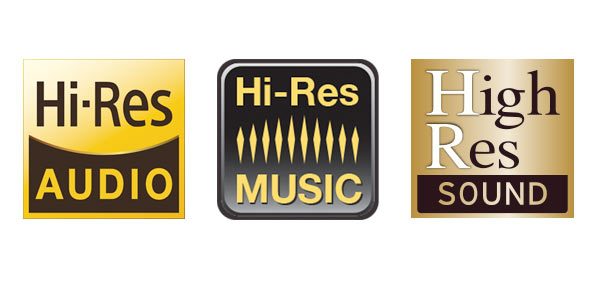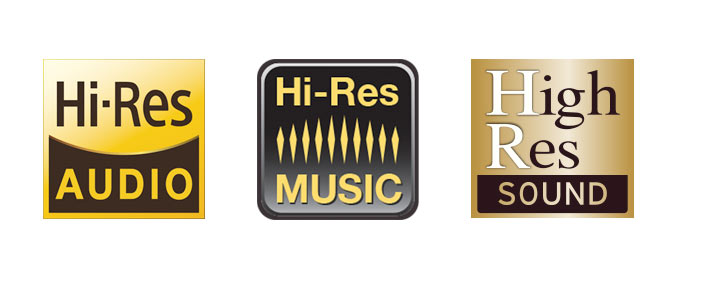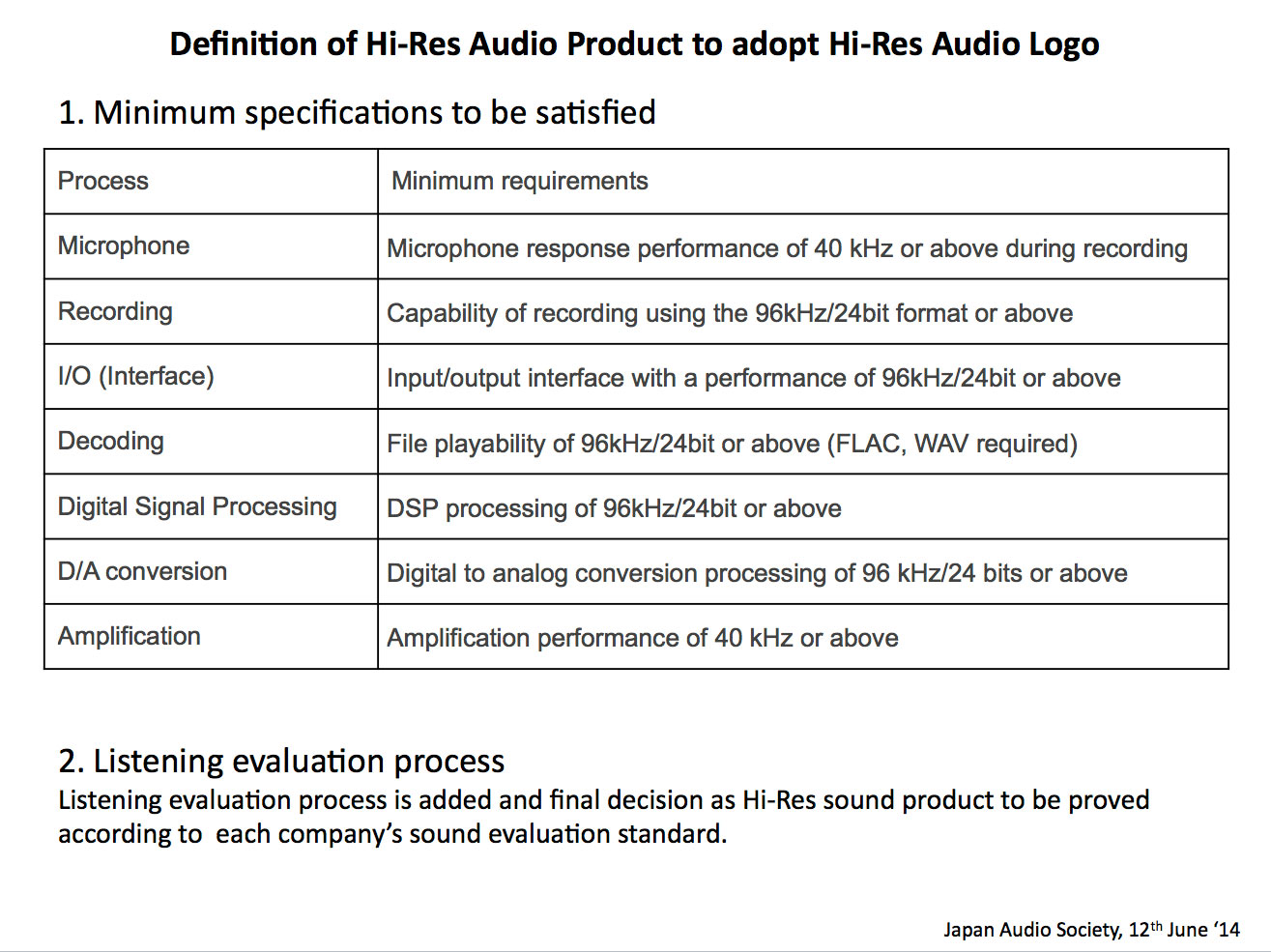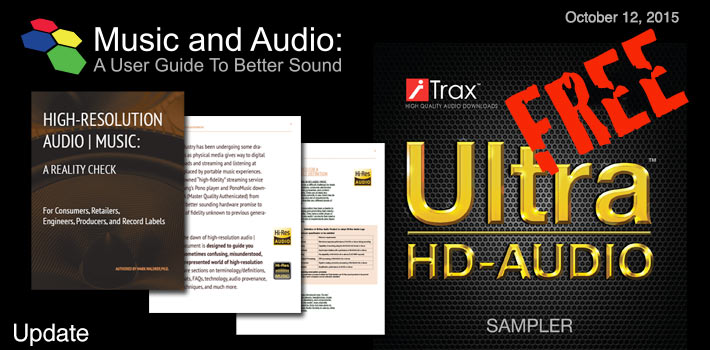And Hi-Res Sound Makes Three!
Yesterday I clicked on a FB link to a recent JAS meeting where Robert Stuart of MQA and Meridian had apparently just given a presentation. You may remember that the Japan Audio Society is the group that was entrusted with the Hi-Res Audio name and logo courtesy of Sony. In one of the photos, I was quite surprised to see another logo for “hi-res sound”. Apparently, Panasonic commissioned and has begun to deploy their own trademarked “hi-res sound” logo. This is disturbing news since we already have two logos…who would have thought that another was necessary?
Here’s the three of them side by side:
Figure 1 – There are now three logos for essentially the same thing…this might lead to some confusion, don’t you think?
Let me see if I can shed a little light on this subject. The first logo to appear was the Sony produced “Hi-Res Audio” logo. It came with a set of requirements (see below):
Figure 2 – The JAS table of requirements for using the Hi-Res Audio logo.
Notice there’s no mention of this logo being reserved for hardware only. I found this out after asking a representative of the JAS. Indeed, I received written confirmation that their logo is to be used exclusively for hardware. However, some folks at some organizations haven’t gotten the message. For example, there is a new guide being written for retailers that hopes to educate those responsible for selling this exciting new format at select Magnolia stores and other retail outlets. Here’s their draft definition on the term Hi-Res Audio or HRA, “A blanket term used to describe digital music files and associated audio playback equipment that allow ‘better than CD’ sound quality, with CD sound quality defined as 44.1-kHz/16-bit resolution”. They know this definition runs counter to the JAS definition but that doesn’t seem to matter.
The Sony/JAS “Hi-Res Audio” logo is ONLY for equipment.
So where does that leave the content people at the labels and the high-resolution download sites? Not to worry, last summer they came up with their own term and logo. They call their upconverted, standard-definition tracks “Hi-Res Music” after they’ve been transferred to high-resolution PCM containers. Their charade should be pretty well known by now…but they keep trying to convince unsuspecting audiophiles to repurchase old recordings in hi-res buckets instead of encouraging their artists and producers to make new high-resolution albums. I haven’t seen their logo in use on any software as yet. Perhaps that’s why they want to tuck content under the HRA umbrella and use the term “blanket” when referring to the old logo.
Initially, the HRA term and logo seemed to establish real high-resolution requirements for the emerging world of hi-res audio. I was very much a supporter of their campaign and when the CEA was approached about coordinating the term and logo in this country, it was discussed and seemed poised to move forward. But things fell apart and we had two logos with contradictory requirements.
And now it seems we have another player. I can only imagine the executives at Panasonic discussing the adoption of the Sony logo and balking. It’s simple enough to design yet another logo and associate that one with their line of products…again hardware only. From what I can tell, this is where we are today.
Remember the press release issued by the DEG, CEA, NARAS, and major labels in the summer of 2014 that tried (and failed) to define “high-resolution audio”…both hardware and content? In the cause of clarity and so as to avoid confusion, they spelled everything out for the press and consumers. I’m not convinced pushing another logo on consumers will help accomplish that goal.
+++++++++++++++++++++++++++++++++++++++++++++++++++++++++++++++++++++++++++++++++++++++++++++++++++++++++++
3 Days and counting down for the “Music and Audio” A User Guide To Better Sound”. If you’ve been waiting for the right time to join the 700 backers, now is the time. I’ve added a second stretch goal. Check it out by clicking here.





Ambiguity reigns, and no one better than marketeers to deploy. I for one, have little hope to encourage would be audio enthusiasts for anything other than modern day CDs. I don’t envy anyone in the hardware business, the most “inclined” will be the least “inclined ” to step into muddy water. Everyone suffers and moving forward is coming to a crawl. Loved the story on Shannon, Mark, move back to the 45th parAppel, the “air’s” clean here !
Instead of clearing up the muddy waters they just seem to be adding more pollution to the mix in spite of good intentions. I don’t see a resolution in site any time soon and don’t have any recommendations worth adding. 🙁
What we need is an independent register, but I guess verification is impossible. Clearly a voluntary standard will never be trustworthy. The best hope is that distrust becomes sufficient so that producers compete on basis of claims to authenticity. Thanks Mark for moving this along, following your emails has been a great education.
Best wishes, martin
This is what the HRADB.com site is supposed to be…but I just haven’t had time to get it rolling.
The term HD-Audio is used a lot on this website (frequently with capital letters). I’ve never been able to tell if it has a precise meaning or if it is a generic term.
When I started this blog, there were no logos, not terms, not consensus on what to call it. I like HD-Audio because of the tie-in to HD-Video…but things changed and I lost that battle. My term still lingers on and still feels the best to me.
Thanks!